
The Sunniest City in Texas is Expanding … Natural Gas Production
After New Mexico rejected a proposal for the El Paso power plant, the Biden administration could be El Paso’s last line of defense.

A version of this story ran in the March / April 2021 issue.
Above: Advocates are pushing for El Paso Electric to invest heavily in solar power, an abundant clean energy resource in the region, which is one of the sunniest in the country.
Jeanette Lara is one of a handful of doctors who serves the small, unincorporated community of Chaparral, New Mexico. Every day, when she drops off her 8-month-old son to his grandparents before work, she drives past the Newman Power Station, a natural gas plant just across the Texas border in El Paso, which provides power to residents in both states.
The gas plant is responsible for nitrogen oxide and volatile organic compound emissions, which can form ozone, or smog. Last August, El Paso had one of its worst days of air pollution in nearly 20 years, as ozone and particulate matter levels spiked sharply. Although it’s likely that the summer’s record-breaking West Coast wildfire season contributed to the pollution peak, El Paso’s air quality has been worsening over the past few years, driven mainly by local sources like cars, refineries, and industrial plants. In 2020, data from the Environmental Protection Agency (EPA) shows that compared to its five-year average, the El Paso region experienced 20 fewer “good” air quality days per year and four more “bad” air quality days, which can be dangerous for vulnerable populations.
“The power plant has been here as long as I can remember,” says Lara, who grew up in Chaparral and now lives in nearby Las Cruces. “It affects me, and my family and friends, the people I care about in this community.” She worries that in the future, her son might develop asthma, as she has from breathing in excess pollution. Her father, who has lived near the plant for three decades, developed a chronic lung condition that leaves him winded.
Last year, El Paso Electric, the company that owns and operates Newman Power Station, proposed upgrading the plant with more efficient generators and decommissioning older, more polluting equipment that is, in some cases, more than 60 years old. While the company says that the new generators will lead to a 25 percent reduction in greenhouse gas emissions, the plant will still create ozone-causing emissions.
In December, the New Mexico Public Regulations Commission, which oversees utilities, rejected El Paso Electric’s proposal, saying that the plant would be obsolete within a few years under the state’s clean energy mandates. By 2045, El Paso Electric will not be able to sell any natural gas-generated electricity to its New Mexico customers—and the state agency won’t make residents pay for a project they can’t use.
But nothing is stopping the company from selling all of its natural gas power to Texas, and making Texans pay the full price. The Texas Public Utility Commission has already approved the plan to upgrade the power plant. A representative from El Paso Electric told the Observer that the company is moving ahead on the upgrade as it waits for a final air permit from the Texas Commission on Environmental Quality (TCEQ).
But there’s one more roadblock in the way that could make it more difficult for El Paso Electric to upgrade: This year, the EPA is expected to review whether or not El Paso’s ozone levels meet federal guidelines under the Clean Air Act.
Two years ago, residents of Sunland Park, New Mexico, sued the EPA, alleging that the agency had failed to accurately review El Paso’s air quality data. By ruling that El Paso wasn’t in violation of federal ozone standards, the EPA avoided triggering strict air quality regulations in the city, which is responsible for a quarter of the region’s ozone pollution—even though smaller, neighboring communities like Sunland Park were in violation. Last summer, a judge ruled in Sunland Park’s favor, forcing the EPA to review its designation.
David Baake, the lawyer on that case, is hopeful that the agency will now move quickly under the leadership of Joe Biden’s appointee, Michael Regan, considered an ally by some environmentalists. “The court told the EPA to do this as soon as possible—and six months later, nothing has happened,” he says. “We’re hopeful the Biden administration will say, ‘Look, you need to get this fixed.’”
If the EPA rules that El Paso is, in fact, in violation of federal ozone standards, new sources of pollution will face a much stricter permitting process. In order to ensure that the new turbines at the power plant don’t add to the region’s ozone problem, El Paso Electric would likely be mandated to invest far more in emissions reductions technology for nitrogen oxides and volatile organic compounds.
But there’s a catch: If the gas plant receives its Texas permits before the EPA hands down a ruling, the plant essentially gets grandfathered into any federally mandated plans to reduce emissions. Most Clean Air Act regulations are aimed at new sources of pollution, Baake says, and the burden on existing sources is much lower. In other words, with a state permit, the federal government can’t mandate that companies pay for major emissions reduction technology on existing sources of pollution.
“I’m sure [El Paso Electric] is aware of this and I’m sure they’re racing,” Baake says, “Texas being Texas, they will bend over backwards to help polluters—I think it’s going to be a real close finish.”
The area most immediately impacted by the gas plant’s pollution is predominantly lower-income, mixed status, and Latinx, says Miguel Escoto, a field organizer with the environmental watchdog Earthworks. “This is a microcosm of a lot of different climate justice issues,” he says.
Last summer, El Paso Electric was sold to a private equity fund affiliated with JP Morgan, one of the largest financiers of the fossil fuel industry— including major fracking projects in the Permian Basin. El Paso Electric’s more efficient plant will likely source natural gas from those same oil fields, where greenhouse gas pollution is a major problem. “We should be going the opposite direction, shutting these plants down and transitioning to renewable energy,” Escoto says.
Advocates are pushing for El Paso Electric to invest heavily in solar power, an abundant clean energy resource in the region, which is one of the sunniest in the country. (So far, the company has committed to building 200 megawatts of solar generation.) Escoto has been working to mobilize opposition to the plant and educate residents about the regulatory process, alongside advocates like Lara and environmental groups like the Sierra Club’s Rio Grande Chapter and the Sunrise Movement, a youth-led climate action organization.
“It’s been challenging to spread the word,” Lara says. “Sometimes people don’t understand that they have a voice—they can speak up and say that, ‘I don’t want this to happen to my community’.”
In November, the coalition successfully mobilized dozens of El Paso residents to voice their concerns at a TCEQ public hearing on the plant’s pending air permits. Residents spoke up about their health concerns, particularly as coronavirus cases devastated the region. The virus can be more deadly for people with pre-existing respiratory conditions, and studies have linked air pollution exposure as a major risk factor.
“What we’re targeting is preventative health,” Lara says. “It’s already bad because the power plant is there.” They just want to prevent the air from getting worse.
Update: The original version of this story said that if approved, El Paso ratepayers would pay for the natural gas plant. We’ve updated the language to clarify that all of the company’s customers in Texas would be affected.
Read more from the Observer:
-
Editorial: Texas Wasn’t Prepared for the Statewide Vaccine Rush
My elderly parents’ experience getting the COVID-19 vaccine highlights problems with Texas’ overall pandemic response. -
What to do With a “Tidal Wave” of Texas Wind Turbine Blades: The wind energy industry is struggling to find sustainable solutions for fast-accumulating piles of dead wind turbine blades. So far, all the options come with an environmental price.
-
Exploring the Rise, Fall, and Lingering Trauma of the Death Penalty in Texas: In his new book, journalist Maurice Chammah ties Texas’ embrace of capital punishment to the state’s frontier mythos.


